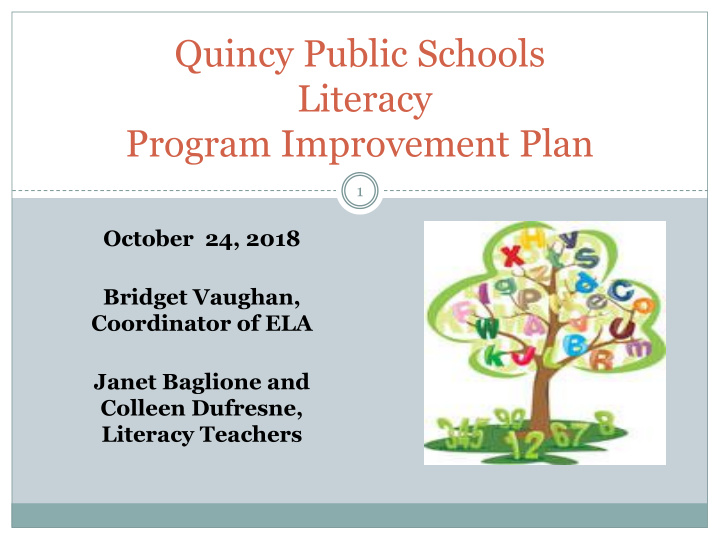



Quincy Public Schools Literacy Program Improvement Plan 1 October 24, 2018 Bridget Vaughan, Coordinator of ELA Janet Baglione and Colleen Dufresne, Literacy Teachers
What is the QPS Literacy Program? 2 ● A program developed to identify and support students who struggle to acquire foundational literacy skills. ● Students are selected by the Integrated Learning Team (ILT) based on test assessment results and overall reading performance. ● Literacy teachers provide intervention, utilizing scientifically-based, researched-reviewed programs (SBRR), to struggling readers in grades kindergarten through grade four.
A Tiered System of Support 3
Intervention Menu 4
Literacy in Action 5
Reflection on 2017-2018 Goals 6 Goal 1: During the 2017-2018 school year, early literacy students will improve their phonemic awareness and phonics skills as evidenced by an overall decrease in the number of Tier 3 students by 3% at each grade level K-2, with a focus on continued improvement on grades K, 1, and 2, as indicated by the DIBELS Next . Reflection: The goal for the 2017-2018 school year was to decrease the number of Tier 3 students (those in need of intensive support) by 3% at each grade level K-2. The percentage of students, K-2, in Tier 3 decreased by a total of 34%.
Reflection on 2017-2018 Goals 7 Summary: Evidence shows a decrease of Tier 3 students when subtests are the same. In winter and spring, nonsense word fluency shows a decrease of 6% , from 52% to 46%. This is not assessed in fall.
Reflection on 2017-2018 Goals 8 Summary: Tier 3 students in kindergarten decreased 13% on the Letter Naming Fluency subtest, from 48% in the fall, to 35% in the spring. This is the only common subtest for all 3 benchmarks.
Reflection on 2017-2018 Goals 9 Summary: Tier 3 students in Grade 1 decreased 26% from 45% in the fall, to 19% in the spring. Tier 1 students increased 18% , from 36% to 54%, fall to spring.
Reflection on 2017-2018 Goals 10 Summary: Tier 3 students in Grade 2 decreased 6% from 32% in the fall, to 26% in the spring. Tier 1 students increased 6% , from 44% to 50%, fall to spring.
Reflection on 2017-2018 Goals 11 Goal 2: During the 2017-2018 school year, the literacy team will support the district goal in the area of reading comprehension through the implementation of guided reading and close reading strategies, as evidenced by an increase of 10 points on the RIT scale as indicated by the district level results on MAP Growth assessments. Reflection: Grade 2 had an average fall RIT score of 179.5 and an average spring RIT score of 193.7. This is an increase of 14.2 points and exceeded the goal of an increase of 10 points. Grade 3 had an average fall RIT score of 191.4 and an average spring RIT score of 203.1. This is an increase of 11.7 points and exceeded the above stated goal.
Reflection on 2017-2018 Goals 12 Summary: Both grades 2 and 3 students increased by more than 10 RIT points on the MAP Growth assessments. Grade 2 students increased 14.2 points from fall to spring. Grade 3 students increased 11.7 points from fall to spring.
Reflection on 2017-2018 Goals 13 Goal 3: During the 2017-2018 school year, to support the needs of the most concerning students, the literacy team, in collaboration with their grade level colleagues, special education, and EL Teachers will work with a representative from NWEA on the effective/manageable use of reports and in-depth data analysis to be implemented during ILT and mini ILT meetings. Reflection: As a result of training, during ILT and mini ILT meetings, more effective use of reports, such as synthesizing data, content, and instructional resources have been put into practice. The literacy team would like to continue this practice by providing more support to colleagues and increase communcation with parents.
Literacy in Action 14
Goals for 2018-19 15 Goal 1: During the 2018-2019 school year, early literacy students will improve their phonemic awareness and phonics skills as evidenced by an overall decrease in the number of Tier 3 students by 3% at each grade level K-2, with a focus on continued improvement in grades K, 1, and 2, as indicated by the DIBELS Next (Grades 1 and 2-all subtests, Grade K- Letter Naming Fluency).
Goals for 2018-19 16 Goal 2: During the 2018-2019 school year, the literacy team will support the district goal in the area of reading comprehension through the implementation of guided reading and small group close reading strategies, as evidenced by an increase of 10 points on the RIT scale for grades 2 and 3 as indicated by the district level results on MAP Growth Assessments.
Goals for 2018-19 17 Goal 3: During the 2018-2019 school year, to support the needs of the most concerning students, the literacy team will provide more manageable and effective use of MAP reports and MAP resources to classroom, special education and EL teachers and parents.
Professional Development 18 Close Reading with Dr. Nancy Boyles Whole group instruction: kindergarten ❖ Small group instruction: grades 1 and 2 ❖ ❖ Creating close reading lessons: grades 1 and 2 Social Emotional Learning (SEL) Concepts and Focus Areas in ❖ Books: grades 1-5 ❖ Small group text connections: grades 3-5 ❖ Author’s Craft in Writing: grades 3-5 Literacy Team Meetings ❖ analysis of data and ILT progress updates ❖ MAP Reports and Resources Google Drive
Literacy Team 19
Thank you for your support! 20
Recommend
More recommend